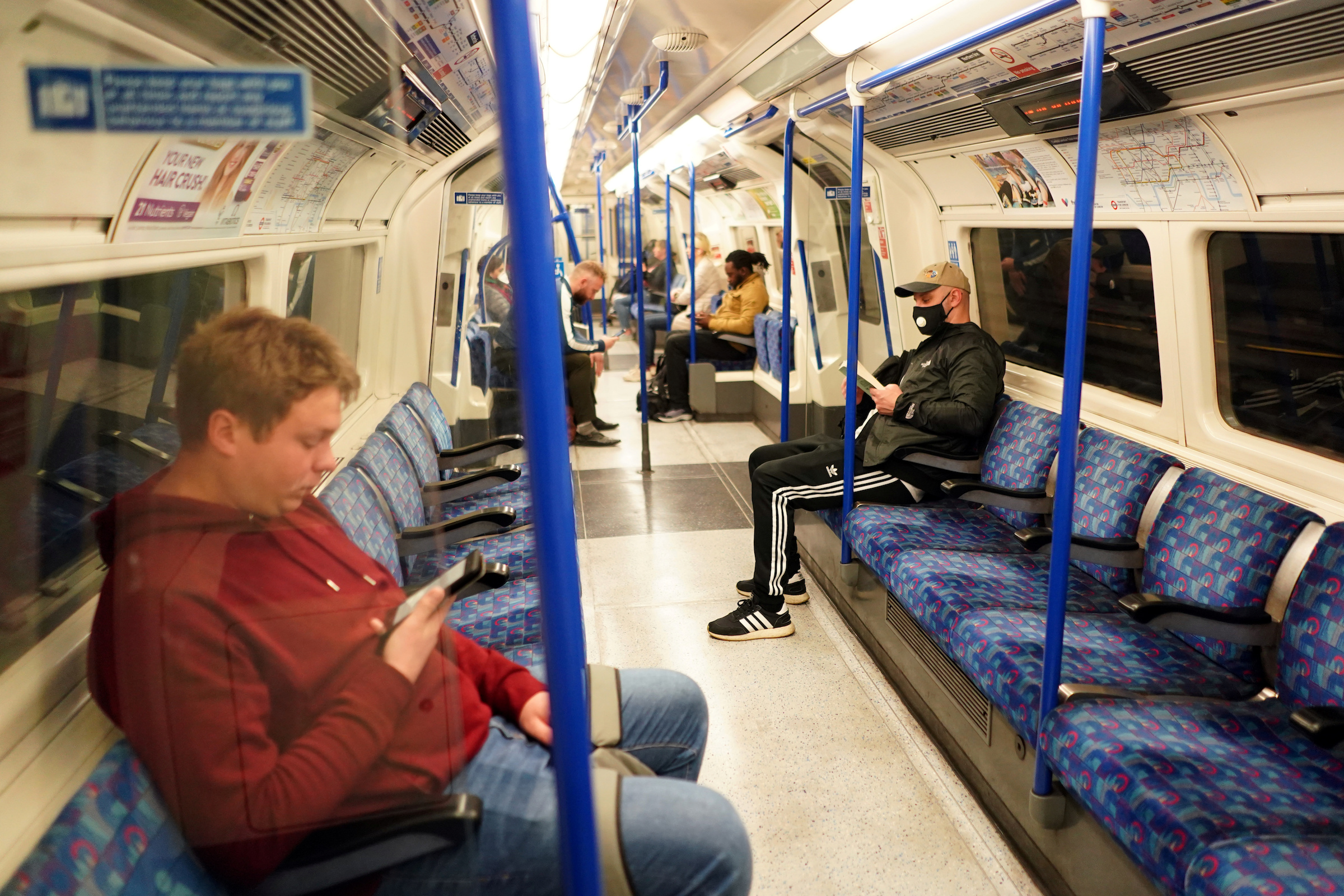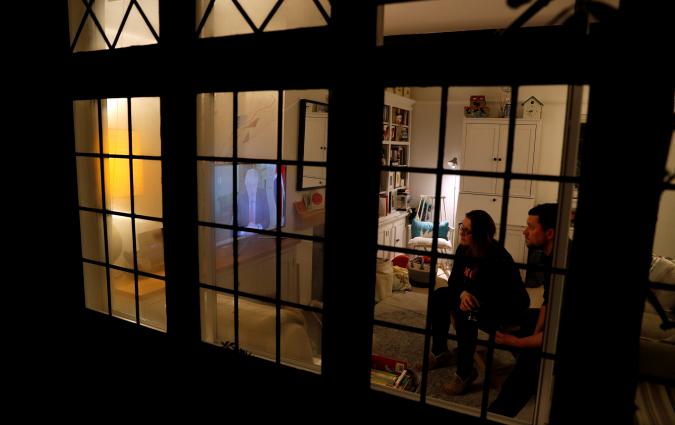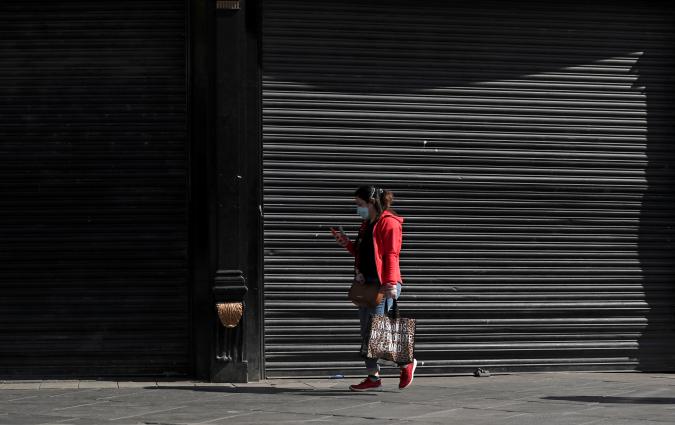Initial surge in news use around coronavirus in the UK has been followed by significant increase in news avoidance

A man is seen wearing a protective face mask on a London underground train following the COVID-19 outbreak near London. REUTERS/Henry Nicholls
In this piece
Key Findings | Overview | Findings | References | About the Authors | Funding acknowledgementsThis is the third factsheet of the UK COVID-19 news and information project.
DOI: 10.60625/risj-qrkn-pb36
Key Findings
In this Reuters Institute's factsheet we examine people’s news avoidance during the coronavirus pandemic in the UK based on a survey fielded from 7 to 13 May 2020.
We find that:
- After an initial surge in news use, there has been a significant increase in news avoidance, with 22% saying they often or always actively try to avoid the news (up from 15% in mid-April), growing to 59% if those who say they sometimes actively avoid the news are included (up from 49% in mid-April).
- Women (26%) are more likely to avoid news than men (18%), compounding existing gender inequalities in news use, both probably at least in part due to unequally distributed caring responsibilities.
- The vast majority of those who always or often avoid news (86%) say they are trying to avoid COVID-19 news at least some of the time, and most of them said they are primarily worried about the effect it has on their mood (66%). 33% say they feel there is too much news, and 28% say they avoid news because they feel there isn’t anything they can do with the information.
- More people say they are actively avoiding news that rely on intentional choice (television, news websites/apps) than say they actively avoid news they may come across incidentally while doing other things (on social media, or sent to them via email and messaging apps).
- 30% think that the coronavirus situation in the UK is heading in the right direction (down from 35% in mid-April), and 20% (up from 10% in mid-April) think the UK is on the wrong track. Just under half (45%) think the picture is mixed.
Overview
This is the third in a series of ten factsheets based on an ongoing online panel survey of a representative sample of the UK population. The survey was designed by the Reuters Institute for the Study of Journalism at the University of Oxford to collect data on how people navigate news and information during the coronavirus pandemic and was fielded by YouGov. Ten waves will be fielded at two-week intervals. Top-line findings from each will be published soon after in a factsheet, with more in-depth analysis to follow. More details about the project and the methodology can be found on the project website. The survey is a mix of tracking questions and specific questions fielded only in some waves.
Findings
The numbers are even higher if we include, in addition to those who say they always or often actively avoid the news, those who say they sometimes do so, up from 49% in the first wave, to 58% in the second, and 59% in the third.
In March and April, the UK saw a surge in news use as people turned to different media for more information about the crisis and the government response (Nielsen et al. 2020). However, in this factsheet we document a significant subsequent increase in news avoidance, with the number of people saying that they actively seek to avoid news often or even always growing from 15% in mid-April to 22% in mid-May (see Figure 1).
Figure 1. Proportion that always or often avoid news
Q1di_2017. Do you find yourself actively trying to avoid news these days? Base: Total sample wave 1 = 2,823, total sample wave 2 = 2,291, total sample wave 3 = 1,973.
Just 20% of our respondents say they never actively seek to avoid news. When we asked the same question in a survey conducted in early 2019, the figure was 36% (Newman et al. 2019). In early 2017, it was 48% (Newman et al. 2017).
News avoidance is evenly distributed across different social groups, with small differences based on income, education, and political orientation. However, we find some significant age and gender differences. Those aged between 25 to 44 (some of whom will be parents with young children) are more likely to say they always or often avoid news (28%) than adults under 25 (19%) and above 45 (19%). Women (26%) are also more likely to avoid news than men (18%) (Figure 2).
Figure 2. Proportion that avoids news (always/often) by gender
Q1di_2017. Do you find yourself actively trying to avoid news these days? Base: Males = 960, females = 1,013.
A gender gap in news avoidance in the UK has been identified before the pandemic and it is partly related to structural gender inequalities in caregiving responsibilities (Toff and Palmer 2018). Given the increases in (unequally distributed) caregiving responsibilities during the lockdown, gender inequalities are likely to have increased even further. They compound existing gender inequalities in news consumption.
The vast majority of those who always or often avoid news (86%), say they are trying to avoid COVID-19 news at least some of the time. In the following sections, we focus specifically on those who say they avoid coronavirus news.
When asked about the reasons for avoiding news, most respondents who always and often avoid news about COVID-19 said that they are primarily worried about the effect it has on their mood (66%) (Figure 3).
Figure 3. Proportion of COVID-19 news avoiders that avoid news for each reason
AVOID1. You said that you find yourself actively trying to avoid news. Which of the following, if any, are reasons why you actively try to avoid news? Please select all that apply. Base: News avoiders (often/always) who avoid news about COVID-19 = 364.
As respondents said in open-ended responses: ‘The news currently makes me feel incredibly stressed’ and ‘I am bombarded with negative news’. A third of respondents (32%) said they avoid news because they don’t trust it, a reason cited by 49% of news avoiders who identify as right-wing.
Only 5% of news avoiders said they avoid news because they are not interested in it. When given the opportunity to provide other reasons for news avoidance, many respondents mentioned that the news is very repetitive these days: ‘News is always the same’ or ‘Too much of news is repeated and speculative’.
To understand how news avoidance takes place, we asked respondents where they are most likely to avoid news. The vast majority (78%) avoids news on television and 55% avoids looking at news websites or apps of news organisations. Around half of news avoiders (49%) are avoiding news they see on social media (e.g. Facebook or Twitter) and 37% ignore news stories people sent to them via email or messaging applications like WhatsApp (Figure 4).
Figure 4. Proportion of COVID-19 news avoiders that avoid news on each.
AVOID4. You said that you find yourself actively trying to avoid news. Which of the following, if any, are you doing to avoid news? Please select all that apply. Base: News avoiders (often/always) who avoid news about COVID-19 = 364.
With the exception of radio, which often serves as a background for other activities, and print, where the picture is mixed, more people say they are actively avoiding news accessed via channels that require an intentional choice (choosing to watch a television news programme, going directly to a news website or app) than say they actively avoid news that they may come across incidentally while doing other things such as staying in touch with friends and family (news seen on social media, forwarded by email or messaging apps).
Incidental exposure to news is in part about how different media operate, but also about people’s assumptions. Those respondents who say they know that ‘the news will find me’ without them having to intentionally seek it out are more likely to say that they often or always actively seek to avoid news about COVID-19 (Figure 5).
Figure 5. Proportion that does not worry about keeping up with the news because they think news will find them
QNFM: To what extent do you agree or disagree with the following statements? I don’t worry about keeping up with the news because I know news will find me. Base: News avoiders (often/always) who avoid news about COVID-19 = 364, total sample = 1,973.
Previous studies have shown that those who hold such news-will-find-me perceptions are likely to have lower levels of knowledge about current affairs (Gil de Zuñiga et al. 2018).
Finally, our survey was in the field from 7 May to 13 May, a period in which hospital deaths from COVID-19 in the UK grew from 30,076 to 32,692 (Roser et al. 2020). During this period there was news coverage around the UK’s position as having the highest death toll in Europe, and the Prime Minister’s speech delivered on Sunday 10 May outlining some steps towards the ease of the lockdown.
Overall, 20% of respondents thought that the coronavirus situation in the UK was on the ‘wrong track’, up from 10% in mid-April. The majority of respondents say they either thought the UK was heading in the ‘right direction’ (30%), down from 35% in mid-April, or that the picture was mixed (45%) (Figure 6).
Figure 6. Proportion that think the coronavirus situation in the UK is generally heading in the right direction
Q19. All in all, do you think the coronavirus situation in the UK is generally headed in the right direction, or do you feel things are off on the wrong track? Base: Total sample: 1,973.
References
- Gil de Zúñiga, H., Weeks, B., Ardèvol-Abreu, A. 2017. ‘Effects of the News-Finds-Me Perception in Communication: Social Media Use Implications for News Seeking and Learning about Politics’, Journal of Computer-Mediated Communication, 22(3), 105-123.
- Newman, N., Fletcher, R., Kalogeropoulos, A., Levy, D. A. L., Nielsen, R. K. 2017. Reuters Institute Digital News Report 2017. Oxford: Reuters Institute for the Study of Journalism.
- Newman, N., Fletcher, R., Kalogeropoulos, A., Nielsen, R. K. 2019. Reuters Institute Digital News Report 2019. Oxford: Reuters Institute for the Study of Journalism.
- Nielsen, R. K., Fletcher, R., Newman, N., Brennen, J. S., Howard, P. N. 2020. Navigating the ‘Infodemic’: How People in Six Countries Access and Rate News and Information about Coronavirus. Oxford: Reuters Institute for the Study of Journalism.
- Roser, M., Ritchie, H., Ortiz-Ospina, E., Hasell, J. 2020. ‘Coronavirus Disease (COVID-19)’. Our World in Data. https://ourworldindata.org/coronavirus.
- Toff, B., Palmer, R. A. 2019. ‘Explaining the Gender Gap in News Avoidance: “News-Is-for-Men” Perceptions and the Burdens of Caretaking’, Journalism Studies, 20(11), 1563-1579.
About the Authors
Antonis Kalogeropoulos is a Lecturer in Communication and Media at the University of Liverpool and a Research Associate of the Reuters Institute for the Study of Journalism.
Richard Fletcher is a Senior Research Fellow at the Reuters Institute for the Study of Journalism and leads the Institute’s research team.
Rasmus Kleis Nielsen is the Director of the Reuters Institute for the Study of Journalism and Professor of Political Communication at the University of Oxford.
Funding acknowledgements
Factsheet published by the Reuters Institute for the Study of Journalism as part of the UK COVID-19 News and Information project funded by the Nuffield Foundation.
The Nuffield Foundation is an independent charitable trust with a mission to advance social well-being. It funds research that informs social policy, primarily in Education, Welfare, and Justice. It also funds student programmes that provide opportunities for young people to develop skills in quantitative and scientific methods. The Nuffield Foundation is the founder and co-funder of the Nuffield Council on Bioethics and the Ada Lovelace Institute. The Foundation has funded this project, but the views expressed are those of the authors and not necessarily the Foundation. Visit www.nuffieldfoundation.org.

Published by the Reuters Institute for the Study of Journalism.

This report can be reproduced under the Creative Commons licence CC BY. For more information please go to this link.



